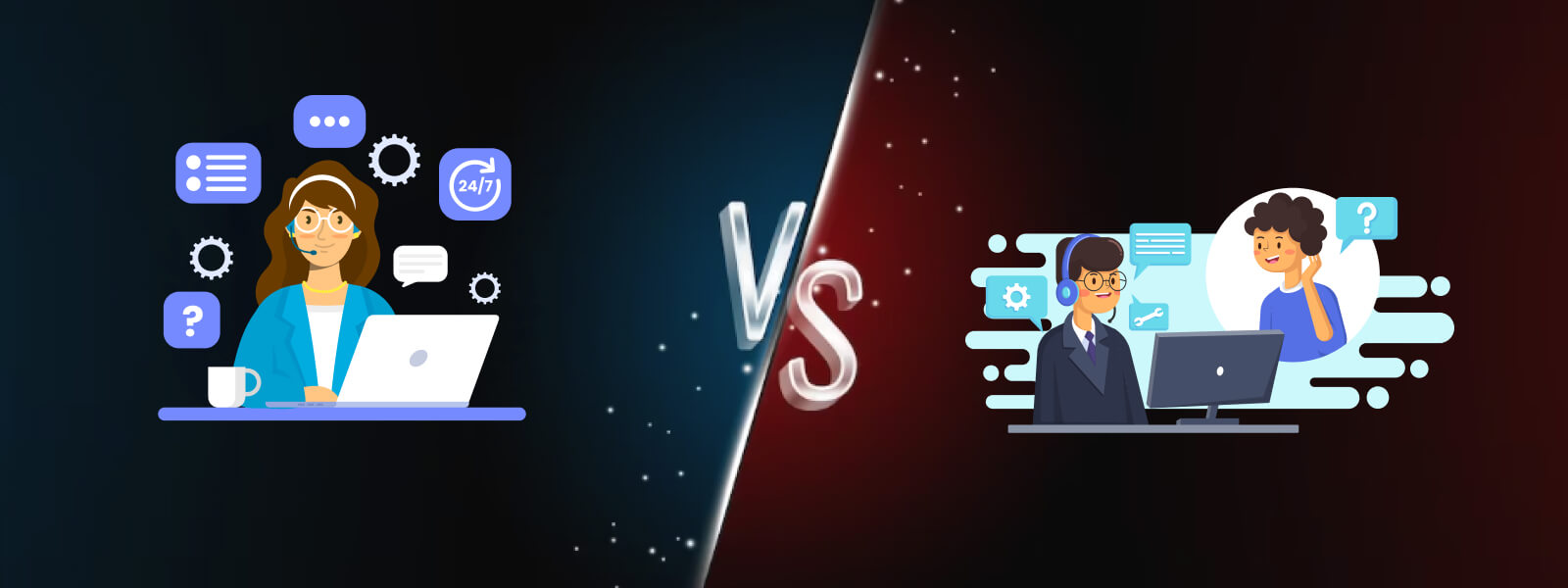” Distinguishing between customer service and customer support lies in their respective roles: customer service aids potential customers, while customer support caters to those already engaged. The broader category of customer service includes customer support as one of its integral components.”
Customer service and customer support may appear to be synonymous but don’t be fooled by their apparent similarity. Each term represents a distinct set of principles, practices, and strategies that can make or break the customer experience. In today’s fiercely competitive marketplace, where consumers hold power, businesses that grasp the significance of these nuances gain a significant advantage over their counterparts.
The Comparative Analysis Between Customer Service and Customer Support
Customer service and support are the heartbeats of any successful business. They build trust, loyalty, and satisfaction, fostering positive relationships. By going above and beyond to understand and meet customer needs, businesses can differentiate themselves, drive growth, and create advocates who fuel their continued success.
Definition: Customer Service Vs Customer Support

Customer Service Definition
Customer service involves all types of interaction between a customer and service provider prior, during, and after a purchase of the product or service.
Customer Service Industry encompasses a broad range of activities aimed at satisfying customer needs, addressing inquiries, and resolving issues effectively. The primary focus of customer service is to deliver exceptional experiences and build strong relationships with customers.
Example: Imagine a customer walks into a retail store seeking information about a particular product. The customer service representative greets them warmly, listens attentively to their queries, provides detailed information about the product’s features and benefits, and offers personalized recommendations. The customer service representative’s goal is to ensure the customer feels valued, informed, and satisfied with their overall experience, irrespective of whether the customer makes a purchase or not.
Customer Support Definition
The definition of Customer support, on the other hand, specifically deals with technical assistance, troubleshooting, and problem resolution related to a product or service.
It involves providing guidance, resolving issues, and ensuring customers can effectively use the company’s offerings. The primary focus of customer support is to address customer concerns and ensure their needs are met in terms of product functionality, maintenance, and usage.
Example: Let’s say a customer encounters a technical issue with a software application they purchased. They reach out to the company’s customer support team via phone or email. The support representative patiently listens to the customer’s problem, diagnoses the issue, and provides step-by-step guidance to resolve it. The representative’s goal is to ensure the customer can successfully utilize the software and minimize any disruptions or frustrations they may experience.
Objectives and Approaches: Customer Service Vs Customer Support
The objective of customer service platform is to design and distribute all types of customer support activities around the platforms. Customer support empowers core values of customer services by resolving the incurring issues continuously.
Customer Service
- Objective: To provide a positive overall experience and build customer relationships.
- Approach: Focuses on empathy, personalized interactions, and creating emotional connections.
- Goal: Customer satisfaction, loyalty, and brand advocacy.
- Strategies: Active listening, relationship-building, effective communication, and exceeding customer expectations.
- Outcome: Strong customer loyalty, increased customer lifetime value, and positive brand reputation.
Customer Support
- Objective: To resolve specific product or service-related issues and ensure smooth usage.
- Approach: Emphasizes technical expertise, problem-solving, and providing solutions.
- Goal: Issue resolution, customer empowerment, and product/service usability.
- Strategies: Technical knowledge, troubleshooting skills, responsiveness, and accurate problem diagnosis.
- Outcome: Customer satisfaction, reduced churn, and enhanced product/service functionality.
Comparing the Interaction Points Between Customer Service and Customer Support

Customer Service Interaction
Customer service involves interactions with customers at various touchpoints throughout their journey with the company. It includes pre-purchase inquiries, sales assistance, post-purchase support, feedback collection, and handling complaints. The scope extends beyond resolving immediate issues and focuses on building rapport and loyalty.
Customer Support Interaction
Customers interact with customer support when encountering technical difficulties, experiencing errors or bugs, seeking assistance with installations or updates, or needing guidance on how to use certain features of a product. They often leverage making use of various customer service tools.
How Customer Service and Customer Support Impacts Customer Experience Differently
Understanding the nuances between customer service and customer support is crucial, as each wields a distinct influence on the overall customer experience.
The Proactive Approach – Service
Customer experience is enhanced by proactive customer service practices. Proactive customer service involves anticipating customer needs, addressing potential issues before they arise, and providing relevant information and support even without customer initiation. It focuses on being one step ahead, anticipating pain points, and delivering exceptional experiences that go beyond customer expectations.
A proactive customer service approach can include sending personalized emails or notifications to inform customers about upcoming product updates, sharing relevant educational content, providing recommendations based on their preferences, or reaching out to offer assistance based on their browsing or purchase history.
- Personalized attention and tailored recommendations enhance the overall experience.
- Emotional connection and rapport-building foster trust and loyalty.
- Proactive engagement and proactive problem-solving showcase a customer-centric approach.
- Efficient handling of complaints and quick issue resolution leave customers feeling valued.
- Consistent and positive interactions across touchpoints create a cohesive customer journey.
Engagement
Customer service involves continuous engagement throughout the customer journey. It starts right from the initial interaction and extends beyond the point of purchase. Chatbot in customer service is also present to guide and assist customers at every step, providing information, resolving queries, and ensuring a smooth experience. For example, a customer service companies might engage with a prospective customer who has questions about a product or service, guiding them through the features and benefits to help them make an informed decision.
The Reactive Approach – Support
Reactive customer support responds to customer-initiated inquiries, issues, or complaints. It involves providing assistance and resolving problems promptly and effectively when customers reach out for help. The focus is on reacting to specific situations and ensuring customers receive the necessary support to overcome challenges.
When a customer contacts customer support with a specific problem or issue, the support team reacts by actively listening, diagnosing the problem, and providing a solution or workaround to address the customer’s immediate needs.
- Timely response and efficient problem resolution minimize customer frustration.
- Clear instructions and technical guidance empower customers to overcome challenges.
- Expertise and product knowledge instill confidence in customers regarding product usage.
- Accessibility and availability of support channels improve customer satisfaction.
- Supportive and patient interactions build trust and reassurance during troubleshooting.
Engagement
Customer support comes into play when customers face problems or need assistance. It is a reactive approach, focused on addressing specific issues and providing technical support. Customer support representatives jump in when customers encounter difficulties, troubleshoot problems, and offer solutions. For instance, if a customer encounters an error while using a software application, they can reach out to the customer support team for help in resolving the issue.

Balancing Between Proactive Customer Service and Reactive Customer Support
Achieving a balance between proactive service and reactive support is crucial for delivering exceptional customer experiences. Here are five ways to achieve this balance:
- Anticipate Customer Needs: Proactive service involves understanding customer needs and anticipating potential issues before they occur. This can be achieved through customer feedback analysis, data-driven insights, and market research. By identifying common pain points, businesses can take proactive measures to address them, reducing the need for reactive support.
- Personalized Communication: Tailoring communication to individual customers is a proactive approach that fosters a sense of care and attention. By leveraging customer data and preferences, businesses can provide personalized recommendations, relevant updates, and proactive notifications. For example, a clothing retailer can send personalized style suggestions based on a customer’s purchase history.
- Self-Service Options: Offering self-service resources empowers customers to find answers to their questions independently. This proactive approach reduces the reliance on reactive support by providing comprehensive knowledge bases, FAQs, video tutorials, and community forums. Customers can access these resources at any time, resolving common issues without contacting support.
- Proactive Outreach: Initiating proactive outreach to customers can help identify potential problems early on and address them before they escalate. This can be in the form of customer satisfaction surveys, follow-up emails, or even reaching out proactively to offer assistance based on previous interactions. For instance, a telecommunications company might contact a customer nearing the end of their contract to discuss renewal options.
- Continuous Improvement: Balancing proactive service and reactive support requires an ongoing commitment to analyzing customer feedback, identifying areas for improvement, and implementing changes. Regularly reviewing customer interactions and support data can uncover trends and patterns, enabling businesses to proactively enhance their products, services, and support processes.
The Difference Between Customer Service and Customer Support Training
Customer service representatives focus on effective communication, empathy, and problem-solving. They need to be skilled in active listening, maintaining a positive tone, and understanding customer needs. Empathy is crucial to relate to customers’ emotions and provide personalized assistance. Problem-solving skills help them navigate complex situations and find solutions that satisfy customers.
On the other hand, customer support representatives require technical expertise and issue-resolution skills. They need in-depth knowledge of the product or service they are supporting and the ability to diagnose and troubleshoot problems effectively. Technical proficiency allows them to guide customers step-by-step through resolving issues or escalating them to the appropriate teams for further assistance.

Specific Training Requirements for Customer Service
To excel in their roles, customer service and customer support professionals should undergo specific training tailored to their responsibilities. Here are five training requirements for each role:
- Communication Skills: Training should focus on active listening, clear and effective verbal and written communication, and adapting communication styles to different customer personalities.
- Empathy and Emotional Intelligence: Training should enhance empathy skills, teaching customer service representatives to understand and empathize with customers’ emotions, even in challenging situations.
- Product Knowledge: Comprehensive training on the organization’s products or services is essential for customer service representatives to provide accurate information and answer customer inquiries confidently.
- Problem-Solving Techniques: Training should equip customer service models with problem-solving frameworks and strategies to address a wide range of customer issues effectively.
- Conflict Resolution: Training should cover techniques for handling difficult and irate customers, de-escalating conflicts, and finding mutually beneficial resolutions.
Customer Support Training
- Technical Proficiency: In-depth training on the technical aspects of the product or service is necessary for customer support representatives to diagnose and troubleshoot customer issues accurately.
- Issue Resolution: Training should focus on developing problem-solving skills specific to the product or service that is supported, enabling representatives to guide customers through issue resolution efficiently.
- Documentation and Ticketing Systems: Training should familiarize customer support representatives with the tools and systems used to document customer interactions, track issues, and escalate problems as necessary.
- Collaboration and Escalation: Training should emphasize the importance of collaboration within support teams and provide guidelines for escalating complex issues to higher levels of support or other departments.
- Continuous Learning: Ongoing training is crucial in the rapidly evolving technology landscape. Customer support representatives should receive regular updates on product updates, new features, and emerging issues to stay up-to-date.
How is Customer Service and Customer Support Measured?
Customer service metrics focus on gauging customer satisfaction, loyalty, and overall experience. Common metrics include Customer Satisfaction (CSAT) scores, Net Promoter Scores (NPS), and measures of customer loyalty. Customer support metrics, on the other hand, revolve around measuring the efficiency and effectiveness of issue resolution. Key metrics include first response time, resolution time, and ticket closure rate.

Aligning Metrics with the Goals
- Customer Service: Align metrics with the goal of enhancing customer satisfaction and loyalty. This can involve tracking CSAT scores, NPS, customer retention rate, and measuring repeat purchases or referrals.
- Customer Support: Align metrics with the goal of efficient issue resolution and customer satisfaction. Key metrics may include first contact resolution rate, customer effort score (CES), and customer churn rate.
- Revenue Generation: Track metrics such as upsell or cross-sell rates to measure the success of customer service or support initiatives in driving additional sales.
- Efficiency and Productivity: Measure metrics like average handling time, response time, and ticket backlog to assess the efficiency and productivity of the customer service and support teams.
- Employee Performance and Satisfaction: Monitor metrics related to employee performance, such as customer service representative (CSR) productivity or customer support agent efficiency, to ensure the team is performing optimally.
Role of Customer Service vs Customer Support in Business Strategy

Integrating Service and Support into the Business Strategy
- Unified Customer Experience: Align customer service tips and support strategies to ensure a seamless experience for customers across different touchpoints. This involves integrating communication channels, sharing customer data and insights, and providing consistent messaging.
- Proactive Engagement: Incorporate proactive customer service and support initiatives into the business strategy, such as reaching out to customers before they encounter problems or offering proactive updates and recommendations.
- Continuous Improvement: Regularly collect feedback from both customer service and support interactions to identify areas for improvement in products, services, and customer experience. Use these insights to drive strategic decisions and enhance the overall offering.
- Training and Development: Invest in training and development programs for customer service and support teams to ensure they have the necessary skills and knowledge to align with the business strategy. This includes technical training, soft skills development, and keeping them informed about product updates or changes.
- Collaborative Problem-Solving: Foster collaboration between customer service, support, and other departments within the organization. Encourage open communication, knowledge sharing, and joint problem-solving to address customer issues effectively and drive improvements throughout the business.
Team Structure and Collaboration: Customer Service Vs Customer Support
Customer service teams often require cross-functional collaboration and alignment with other departments. They serve as a bridge between customers and various internal teams, including sales, marketing, product development, and operations. Customer support teams, on the other hand, typically operate as focused teams closely collaborating with technical resources. They work closely with product or technical teams to understand and resolve complex customer issues.

Key Importance of Effective Teamwork
- Knowledge Sharing: Effective teamwork allows for the sharing of expertise, experiences, and best practices among team members. This facilitates faster issue resolution and improves the overall quality of service and support provided.
- Enhanced Problem-Solving: Collaboration enables different perspectives and ideas to come together, leading to more innovative and effective solutions to customer problems.
- Seamless Handoffs: When teams work collaboratively, the transition of customer interactions between departments becomes smoother, ensuring that customers receive consistent and uninterrupted support.
- Continuous Learning and Improvement: By working as a team, customer service and support professionals can learn from one another, identify areas for improvement, and collectively enhance their skills and knowledge.
- Streamlined Communication: Effective teamwork promotes clear and efficient communication, reducing misunderstandings, errors, and delays in customer service and support processes.
Customer Service and Customer Support’s Impact on Business Success
Customer service plays a significant role in driving customer satisfaction, retention, and advocacy. By providing exceptional service experiences, businesses can create loyal customers who are more likely to make repeat purchases and refer others to the company.
Customer support, on the other hand, focuses on resolving issues efficiently and preventing customer churn. By addressing customer concerns promptly and effectively, businesses can retain customers who might otherwise have switched to competitors.

Roles in Achieving Business Success
- Marketing: Effective customer service and support can contribute to marketing efforts by creating positive customer experiences that generate word-of-mouth referrals and positive online reviews.
- Sales: By providing exceptional service and support, businesses can improve customer satisfaction and increase the likelihood of upselling or cross-selling opportunities.
- Product Development: Customer service and support teams are valuable sources of customer feedback, helping identify product or service enhancements that can drive customer satisfaction and retention.
- Operations: Seamless collaboration between customer service and support teams and operational departments ensures smooth processes, timely issue resolution, and overall customer satisfaction.
- Executive Leadership: The executive leadership team plays a crucial role in setting the vision and strategy for customer service and support, aligning these functions with the broader goals of the organization, and providing the necessary resources and support for their success.
Final Thoughts
As we wrap up this exhilarating exploration of the dynamic duo—customer service vs customer support—it becomes abundantly clear that both are essential ingredients for a recipe of excellence in the business world. So, dear readers, armed with the knowledge gained today, it’s time to embark on a journey of exceptional customer experiences. Remember, in the realm of customer satisfaction, excellence is not a destination; it’s an ongoing pursuit that rewards both businesses and customers alike.
You can also check: What Is Saas Customer Support? Strategies & Examples
This is Kawser Md Sayem, and I would like to introduce myself as a content writer. It has been five years since I began my professional writing journey. By this time, I have had the pleasure of working in unidentical industries like publishing, information technology, entertainment, and education
 Customer Service
, Customer Support
Customer Service
, Customer Support









